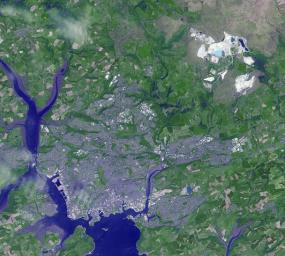The Drakelands Mine (previously known as the Hemerdon Mine) is a historic tungsten and tin mine located northeast of Plymouth, England. Tin and tungsten deposits were discovered in 1867, and the mine operated until 1944. Last year work started to re-open the mine, as it hosts the fourth-largest tungsten and tin deposits in the world. Tungsten has innumerable uses due to its incredible density and high melting temperature. Yet more than 80% of world supply is controlled by China, who has imposed restriction on export of the metal. The image covers an area of 17 by 18.9 km, was acquired June 5, 2013, and is located at 50.4 degrees north, 4 degrees west.
With its 14 spectral bands from the visible to the thermal infrared wavelength region and its high spatial resolution of 15 to 90 meters (about 50 to 300 feet), ASTER images Earth to map and monitor the changing surface of our planet. ASTER is one of five Earth-observing instruments launched Dec. 18, 1999, on Terra. The instrument was built by Japan's Ministry of Economy, Trade and Industry. A joint U.S./Japan science team is responsible for validation and calibration of the instrument and data products.
The broad spectral coverage and high spectral resolution of ASTER provides scientists in numerous disciplines with critical information for surface mapping and monitoring of dynamic conditions and temporal change. Example applications are: monitoring glacial advances and retreats; monitoring potentially active volcanoes; identifying crop stress; determining cloud morphology and physical properties; wetlands evaluation; thermal pollution monitoring; coral reef degradation; surface temperature mapping of soils and geology; and measuring surface heat balance.
The U.S. science team is located at NASA's Jet Propulsion Laboratory, Pasadena, Calif. The Terra mission is part of NASA's Science Mission Directorate, Washington, D.C.
More information about ASTER is available at http://asterweb.jpl.nasa.gov/.

 Planetary Data System
Planetary Data System












